RMR Cold Weather Test

Field Testing the Trijicon RMR in Sub-freezing Temperatures
27 Oct 2020
BOTTOM LINE UP FRONT
Our conclusions, some of which are based on testing and others on reason (/ conjecture) or experience:
- Cold pistol to cold air: No problem
- Body temperature pistol to cold air: No problem
- Cold pistol to warm humid environment: Potential problem (untested on 27 Oct but based on real world experience); train to compensate by learning alternative aiming methods such as OEG (refer to Heloderm’s Optics Failures lesson plan).
- Dropped your pistol in a snow drift: Untested but potential problem. Be prepared to blow or shake snow, rain, or mud out of your RMR. Be prepared for reticle distortion over rain or melted snow droplets. Learn compensatory aiming methods.
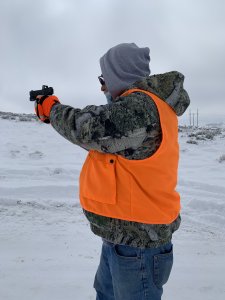
PARTICIPANT BACKGROUND
Assisting me in this endeavor were retired Majors Kurt H and Steve V. Although I was teaching them about reflex sights at the same time, I hesitate to call them “students” or even “clients” as we are really lifelong training partners.
The three of us first trained together on 22 Jul 1980, in an arduous, 10-month screening process for candidates seeking appointments to the USAF Academy in Colorado Springs. Steve and Kurt were both previously enlisted. Kurt had been a Security Policeman guarding the gates at Spangdahlem AB in Germany, with a Smith & Wesson Model 15 on his hip and a GAU-5/A slung across his shoulder. Steve was a radar operator, directing fighter interceptors protecting Florida from Cuban communists (and Nicaraguan Sandinistas, but mostly from Columbian cocaine traffickers). After he got his commission, Steve put similar skills to work defending the largely less than grateful citizens of Cape Cod from Soviet submarine launched ballistic missiles (SLBMs). In Turkey, Steve and his bride Cyndie tracked Soviet space launches, as well as the missiles lobbed back and forth at each other’s cities during the Iran – Iraq war. The data they and others like them gathered was later used to reprogram the Patriot, a surface to air missile (SAM) originally designed to intercept aircraft. The reprogramming enabled the Patriot to intercept intermediate range ballistic missiles (IRBMs) like the SCUD, saving countless lives during Desert Storm and since.
Since the Academy, we had gotten together many times over the years to continue honing ourselves as warriors.
“As iron sharpens iron, so one person sharpens another.”
–Proverbs 27:17 [NIV]
For example, Steve and I took Roger Phillips’ Point Shooting Progressions and Force on Force Gunfighting courses together. Kurt and I hunted wild hogs in Texas. Anthony Herbert, the most decorated American of the Korean war (who later fought in Vietnam as well), wrote in Herbert: The Making of a Soldier that hunting is the best training a rifleman can get. The targets move, and hide, and don’t want to die–similar to enemy combatants.
KREMMLING, 24 – 27 OCT 2020
This time, we gathered in Kremmling, Colorado. Kremmling sits at the south end of Colorado’s Middle Park, about 7300 feet (2229 meters) above sea level, in a bowl between bluffs and mountains, where the Blue River flows into the headwaters of the Colorado River. Our adventure started out, at least partially, as a hunting trip.
STALKING / MARKSMANSHIP
Kurt’s son Tristan, who teaches patrolling to Recon Marines, put a .308 Sierra Match King through the heart of a buck at about 300 meters. There are other, more powerful, flatter shooting cartridges for North American game, but Tristan knows the 7.62x51mm well: what it will do, what it won’t do, where it prints at what distance. I saw the furrow it tore through the mule deer’s heart, and GPS waypoint programs don’t exaggerate about the distance. This proved that the tax dollars you spent putting Tristan through USMC Scout Sniper school were well spent. It also proved, once again, what we constantly tell you: the tools you choose are not nearly as important as your training and ability with them. Tristan chose 7.62 NATO because that’s what he has the most experience with.
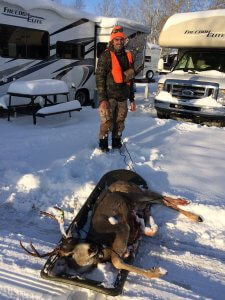
COLD WEATHER SURVIVAL
 Our adventure turned into de-facto Alpine survival training when a winter storm hit, and overnight temps that week dropped to single, then even double, digits below zero Fahrenheit. The power / heating systems of first one, then the only spare, RV gave out. It had been a while since I’d slept with my water bottle inside my sleeping bag so it wouldn’t freeze solid.
Our adventure turned into de-facto Alpine survival training when a winter storm hit, and overnight temps that week dropped to single, then even double, digits below zero Fahrenheit. The power / heating systems of first one, then the only spare, RV gave out. It had been a while since I’d slept with my water bottle inside my sleeping bag so it wouldn’t freeze solid.
RMR / MAGAZINE FUNCTION TESTING
One of my goals for the trip was to field test the Trijicon RMR (ruggedized miniature reflex) sight in cold conditions. I also needed to function test two “#7 follower” OEM magazines that came with a Gen 4 in “Lt Traxler,” the Gen 3 I had equipped with the RMR, but I didn’t need to travel to Kremmling, Colorado to do the latter. However, in this era of panic buying, 9x19mm is getting mighty hard to come by. Even before that, I always believed in squeezing as much usefulness out of every shot as possible. We were able to accomplish both goals with the same ammo.
TESTING LIM FACs
I had planned a much more comprehensive test. The local shooting range was closed, so we went to some BLM land south of the Colorado River where we had a clear view of the impact area (hunters in orange would have stood out well against the white, snow covered terrain) and a large prominence to stop the bullets. Lacking target stands, I was forced to use a small water bottle that had frozen solid in my SUV. It was only at moderate range (say, 10 – 12 meters), since the area was knee-high sagebrush covered in 6 – 12 inches of fine, dry, powdery snow, and I didn’t have anything to prop it on farther afield.
CONDITIONS
Weather had apparently grounded the choppers (including a Blackhawk and this bizarre egg-beater looking contraption with counter rotating props) which had been dropping buckets on the nearby East Troublesome wildfire before the storm hit. Using his cell (our phones actually had more “bars” there than in many bigger towns) Steve said the temp in Kremmling was forecast at 20 degrees F that day. My car sensor said 7 degrees at the time. Suffice it to say it was well below freezing.
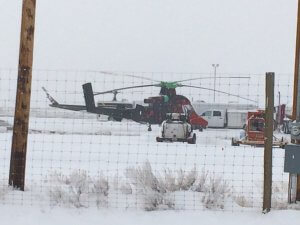
The whole area was covered in the low, thin cloud or “snow fog” of high mountains after a storm. In other words, it was not dim, but not entirely clear either, with soft, diffused light all around (this was significant because we were using a “dual illum” RMR; see below).
DUAL ILLUM RMR BASICS
The RMR on Lt Traxler had a 12.9 MOA green triangle reticle, powered by a “dual illumination” system. The reticle receives light from two sources: tritium, and a light absorbing strip which runs along the top of the sight. In theory, this system automatically adjusts the brightness of the reticle to match the illumination in the room or outdoors. In practice, however, dual illum can be problematic under certain conditions.
If you are in a dark room, the reticle should be dim, so as not to blind you to what you are trying to see behind the reticle, through the sight. The lack of ambient light means only the dim tritium power source is used. However, if you illuminate the target with a flashlight, the area behind the reticle is bright, but there is usually not enough ambient light bouncing off the walls to brighten the reticle through its secondary power source, the optical strip along the top of the sight. The reticle stays dim as the target area lights up.
Dual illums work great in bright daylight, and in complete darkness. However, many urban environments are neither. Think a partially lit parking lot at night, or what it must’ve been like during the 20 July 2012 screening of The Dark Knight Rises at the Century 16 movie theater in Aurora, Colorado. Some light or dark backgrounds also tend to blend in or contrast with different colors of reticle as well.
Powerful flashlights can “wash out” even battery operated systems, but most battery powered systems are adjustable; you can manually “bump up” the brightness of the reticle to compensate for lighting conditions. Unless you are looking for a specific reticle which is only offered in a dual illum system (as I was), I recommend using a battery powered RMR, even though, with the RMR, one must remove the sight to replace the batteries. The batteries last a long time, and most users leave them on all the time, even in the safe at night.
FLASHLIGHTS, IRON SIGHTS, AND RMRs
Although most pistol fights are up close, not requiring any sights, when you need sights, you need them. Irons tall enough to see through the reflex sight are a necessity with reflex sights, for several reasons:
I’m told that when they planned the Son Tay rescue mission, Col Arthur D. “Bull” Simons had a policy that “All mission critical systems must be 100% redundant.” You have two kidneys for a reason. In other words, have backups for your backups.
Everything made by man, including our parents’ children, can fail.
–Massad Ayoob
If the reticle simply isn’t there (dead battery, smashed out glass, whatever) you may want to have those irons.
In many conditions, it can be helpful, perhaps even essential, to locate the easier-to-find iron sights first, then “hand off” your sight picture to the (co-witnessed) reticle. This is one of the ways we train people who are not used to reflex sights to “get to the dot.”
There are certain lighting conditions, such as when you are using a flashlight, where the reticle will be hardly visible but the irons can be clearly backlit. If you are using luminous “night” sights, you won’t need a flashlight to backlight your sights. It’s far easier to find night sights before making the handoff to the reticle than it is to fish around in the dark for a reticle you can’t see when you can’t see the iron sights either. However, if it’s that dark, you probably need a flashlight to identify your potential target as a threat (refer to our Night Fighting courses for details).
I initially obtained this RMR as a possible sighting solution for a person with achromatopsia.
Achromatopsia is rare vision condition that essentially blinds a person in daylight, or even bright indoor light. The person sees better with peripheral vision than with the center of their vision, making it hard to see small things like a front sight post. Achromats, as persons with achromatopsia are known, usually have some degree of color blindness as well, making it difficult or impossible for them to see reticles of certain colors. I chose the 12.9 moa green triangle RMR because it was the largest available, and the only one available in green.
Not wanting to confuse his sighting picture, I chose irons that had no tritium of their own. They practically necessitated a weapon mounted flashlight to silhouette (backlight) the iron sights if necessary.
I chose the SureFire XD1, because unlike many weapon mounted lights, the XD1 is not overly bright. Greg G, a friend and fellow LE instructor, once told me that “A flashlight is too bright when it sets things on fire or it has recoil.” In our line of work, that was usually true. When we were doing traffic stops at night; we would aim our cruiser’s spotlight, and / or our handheld, into the driver’s rearview mirror before approaching the stopped vehicle. That, combined with powerful “takedown lights” atop the LE cruiser give us a “wall of light” to hide behind if the person being stopped to be warned about a busted tail light turned out to be an angry armed felon.
Speaking of which, right now there are well meaning people (and some not so well meaning) who are actually suggesting that traffic enforcement be conducted by unarmed cops, so it can’t escalate into a use of force situation.
No, seriously. They mean it.
Morons.
The “reformers” suggesting that traffic enforcement be conducted by unarmed persons have never conducted a car stop, nor, as my father the three-war veteran said, “heard shots fired in anger.”
Felons almost never turn themselves in to law enforcement. Usually, they must be found. Often, a bad guy with a warrant, say, for rape, vacates his earlier place of residence and hides in a different town. He gets caught when he blows a stop sign and almost runs over some kids in a crosswalk.
That cop who just pulled you over to warn you about the tail light is doing you a favor, but also using that stop to “dig a little deeper.”
If the driver is a serial killer and there is a 13 year old tied up in the trunk, the cop won’t be able to hear the kid kicking on the trunk, from inside her or his cruiser as the killer drives by. But when the officer pulls the serial killer over for failure to signal a turn, the cop might ask, “Sir, is there a reason someone is kicking on the inside of your trunk? Mind if I take a look?”
About that time is when the killer tries to shoot the cop in the face.
“Unarmed traffic enforcement” . . . As Chris Rock would say, that’s “just ign’ant.”
But getting back to the RMR cold weather test, I’d initially set up Lt Traxler for an achromat. Too much light from the flashlight, while blinding to a potential threat, might also have blinded the operator. Too much light can sometimes be counterproductive, even if you have normal vision.
Like the RMR, SureFires have been the gold standard in ruggedness and reliability. I have melted the lenses of cheap Chinese flashlights; that won’t happen with a high-end SureFire because they use the same material as the windscreen of the Space Shuttle. You pay for that ruggedness and reliability–an XD1 costs almost as much as a new pistol–but hey, you shouldn’t go cheap with things you bet your life on. My only complaint with the XD1, after a few years of use, is that it does not have a lockout feature (other than removing the battery).
A lockout is essential for weapon light safety during storage. You don’t need to be inside the fridge to know the light goes out when you shut the door, but closing that gun case can make the light go ON, which at best will drain your battery. At worst, you could start a fire. Several SWAT vans have been destroyed over the years by flashlights with lithium batteries that got knocked (or left) on.
OTHER REFLEX SIGHTS
There are other reputable manufacturers making small reflex sights for pistols now, and I make no attempt to compare and contrast them here. I chose the RMR for its well-established ruggedness and ability to retain its zero despite rough handling.

I had seen an industry rep pound an RMR, sight down, on a wooden table, HARD, repeatedly, like a hammer. Then he tossed the Glock it was mounted on about 30 meters down range onto rocks and dirt. “Pick it up, load it, and shoot it,” he said. “It hasn’t lost its zero.” We did, and he was right.
Whatever you choose, don’t go cheap. Some of the less expensive reflex sights out there are only engineered to handle the recoil of Airsoft, not for saving your life with a centerfire pistol.
ZERO RETENTION
I had zeroed the RMR with the top corner of the triangle as my aiming point.
My first shot, with the “Every Day Carry” (EDC) cartridge that had been in (and out, and back into) the chamber for some time, hit the bottle a bit high but squarely enough to shatter 2/3 of the ice in it. I was wearing gloves without finger cutouts. The gloves were a bit stiff from the weather (they had been moist when taken off the last time, and had subsequently frozen), so it was a little more time consuming for me to work the trigger well. Or should I say, I took a lot of time to do it, whether I needed to or not.
Apparently (within the very approximate parameters of this test) the RMR had not lost much if any of its cold-bore zero. The EOTech, another reflex sight, had a bad reputation for Thermal Drift, a zero which wandered with temperature and / or humidity. See “EOTech Breaks Silence over Defective Sights,” by Matthew Cox (Military.com, 21 Jan 2016). I never experienced Thermal Drift (that I knew of) with the EOTechs we had issued on our M4s, although I did have a devil of a time removing the hermetically sealed battery cover of my EOTech when I had gone down in altitude from Tucson Arizona (a moderate 2389 feet above sea level) to Ft Benning Georgia (377 feet), essentially vacuum sealing it in place.
FOGGING–OR NOT
My main concern with the RMR in the cold was that the glass would fog up, which did not happen during our limited testing. Fogging had happened to a buddy of mine’s EOTech HoloSight when, after waiting in the snow outside in Cheyenne, Wyoming on a cold January night for about 40 minutes, he was first in the door of a heated house with a mouth breathing human moistening the air inside.
A duty pistol worn outside the clothing cools or warms to about the temperature of the environment it’s in. That could be cold (like when I was on a PD in Wyoming) or hot (like when I was in Saudi and Kuwait). It could be humid (like when I was an agent in South Texas) or arid (like when I’ve worked in Arizona, Colorado, Wyoming, and West Texas).
A pistol worn concealed will be somewhere between the ambient temperature and 97 degrees, the approximate outside temperature of your body, and perhaps a little moist or sweaty. When I had strapped it on, Lt Traxler had visible condensation on the side of the slide, from spending the night in the freezing RV with several of us snoring around it. Before this test, the RMR (and Glock) had been in a kydex holster (a Detroit Metro, if you’re curious) underneath a few layers of cotton, fleece, and nylon jacket for a few hours, so it was warmer than the outside air.
Most of our first-world lives are spent inside, or at worst, in an air-conditioned / heated vehicle.
In South Texas, I got so annoyed with my glasses fogging up in the hot, humid air every time I jumped out of my air-conditioned patrol vehicle (and with perching them on my sweaty brow when using binoculars or NVGs, which we did frequently) that I eventually stopped wearing my glasses.
I came to regret that habit on 07 July 1998, when I found myself 70 meters from an active gun battle. I could hear the bullets buzzing off the road beside us, and hear them slinging through the trees behind us, but being moderately nearsighted, I could not tell the good guys from bad at that distance. I had a tool with sufficient reach (an iron sighted M4) but not the optics or eyesight to IFF (Identify Friend from Foe).
Nor had I any excuse, as I had learned years before that FBI agent Ben Grogan, the best shot on their stakeout squad, spent the Miami shootout of 11 Apr 1986 wishing his glasses had not flown off during the multi-car pileup which had been their felony stop. The FBI’s Miami gun battle was a frequently referenced case study in my state law enforcement academy, at FLETC (the Federal Law Enforcement Training Center), and during several of my outsourced shooting courses.
When I deployed to the flat open desert of Kuwait in ’08, I made very sure I had a 4x ACOG on my M4–not so much for precision of the bullet drop compensator (BDC) but rather so I could tell what was going on, and who was whom, downrange. In the event of attack, my main job as a leader would be to tell the troops whom to shoot, and whom not to, like Ron K had to.
TSgt Ron K of FE Warren AFB’s 90th Security Police Group had been escaping the Wyoming winter of ’89 – ’90 on a “boondoggle” TDY to Albrook AFS, Panama, when Operation Just (“B”) Cause began. At one point, Noriega’s PDF troops or Dignity Battalion irregulars began attacking Americans from an open field. A USAF SP fire team flanked the Panamanian forces and began chasing them across the field. US Army troops arrived, and the Army M60 machine gunner began hosing everyone in the field, good and bad alike. Ron yelled “Cease fire!” while waving his palm in front of his face (standard US military hand-and-arm signal for cease fire), repeatedly. The M60 gunner glanced at Ron, then promptly ignored him, continuing to fire belt-fed 7.62mm at all and sundry. Ron kicked the M60 gunner in the ribs, hard, which finally caused him to stop. Miraculously, none of our boys were killed by that “friendly” fire before he did. Down-range SA (situational awareness) is critical, and can be helped or hindered by the optic (or lack thereof) on your weapon.
I’m guessing that a pistol worn outside the clothing will not fog up if you have been outside and you use it outside. It might, instead, have snow or rain on the back of the glass. It stands to reason that droplets on the RMR lens will distort the reticle image. Moving your eye till you can see the reticle through a less distorted part of the glass may get you in the ballpark of where you are trying to aim, as a short-term solution. Again, you almost never need precision with a pistol–until you do.
Going from warmer-than-outside concealed pistol / sight glass to cold outside did not fog the glass, as I should have guessed.
A better test might’ve been to take the colder-than-inside pistol out in a heated Kremmling restaurant. While such a thing might be very necessary in a gunfight, I refrained, as that might not have been socially acceptable over lunch. It was hunting season, and everyone in there was armed, but there is a huge difference, even in those parts, between wearing a holstered pistol and brandishing it unnecessarily. Thus, while this testing was informative and confidence building, it was far less than conclusive.
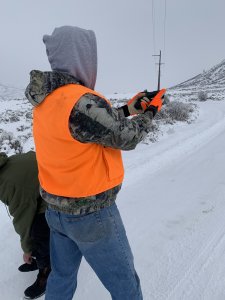
RETICLE VISIBILITY
Despite the less than bright lighting conditions, and the whiteness of the snow, the light green reticle was easily visible and contrasted well with the background. It was harder for me to find the remaining bits of the bottle to shoot at in all that snow and brush than it was for me to see the reticle.
HOW TO USE REFLEX SIGHTS
A COMMON MISTAKE WITH REFLEX SIGHTS IS FOCUSING ON THE RETICLE. They are designed to be used with BOTH EYES OPEN, FOCUSED ON THE TARGET. Which is just as well, since both your eyes will likely be laser bored onto that big dude coming to kill you, who will have your undivided attention. Unlike iron sights, requiring you to unnaturally pull your focus to a 1/8″ piece of metal that is NOT trying to kill you, reflex sights work with your natural proclivities, rather than against them.
TESTING RESULTS
I worked on target focus for the rest of my shots, before handing it off to Kurt and Steve.
As you might expect, the OEM magazines performed flawlessly with my EDC 124 grain Speer Gold Dot +Ps, even with the extra power Wolff spring I had to install to overcome a tolerance stacking problem from an aftermarket slide (a Brownells).
All these people building “ghost” guns have made Glock OEM slides extremely difficult to come by. The Brownells was inexpensive, pre-cut for the RMR, and most importantly available, but the firing pin safety (FPS) hole of mine was not milled out to OEM specs. Consequently, the FPS stuck down a little farther than it should. When I first built Lt Traxler (all parts except the slide were OEM), I experienced failures to return to battery when I would “follow through” on the trigger, holding it to the rear after the shot. As the slide returned forward, the lower than spec firing pin safety hung up on the vertical extension of the trigger bar. The slide would usually (but not always) return to battery when I released the trigger. Polishing the uncooperative parts with a Dremel didn’t completely solve the problem, but the Wolff extra power spring overcame it.
Steve and Kurt had no problems using the RMR or operating the pistol in the cold, with and without gloves (Steve was already a Glock owner).
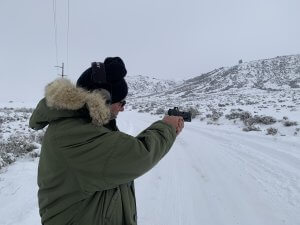
I had planned a more comprehensive “torture test,” scooping snow into the RMR, etc, but our “wildcat” range lacked target stands. A man-sized target would’ve been necessary to practice “Meat and Metal” aiming (framing the threat around the image of your gun and hands). Meat and Metal is usually a close range time saving technique, but it can also be useful if the sights are not usable (for example, you just got into tussle over the gun and now bits of the bad guy’s forehead skin are goobering up your front sight).
In addition to the lack of target stands, we needed to return the rented RV (Tristan called it a “cold storage unit,” ’cause that’s what it ended up being), to Denver before the end of the business day. We didn’t want to spend another night up there without propane. Consequently, we had to cut our cold weather test short.
The short version of this tale is, I was not disappointed by the RMR in a cold environment.
